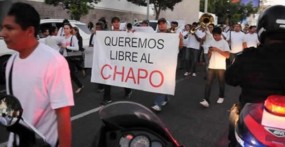Posted on 15 Feb 2018
Organised crime related deaths in Mexico reached record highs in 2017, according to the watchdog agency Semáforo Delictivo and Lantia Consultores and reporting from InSight Crime. In part, the rise in deaths has been attributed to inter-criminal group disputes over control of territories and trafficking corridors, and the splintering of some groups leading to inter-factional fighting. But how best to counter the explosions of violence so often associated with these shifting dynamics in criminal markets? And do traditional counter-crime strategies sometimes serve to entrench the relationship between organised crime and violence?
Previous research has called into question the effectiveness of ‘kingpin strategies’, or ‘targeting of high value individuals’ in bringing about violence reduction. While such strategies may represent the most direct way of disrupting criminal organisations and effectively capture the headlines – such as the extradition of captured Sinaloa cartel leader Joaquín “El Chapo” Guzmán early last year – the resultant breakdown in organisational hierarchies and the creation of power vacuums may have unintended, and deadly, results.
A new policy brief from Justice in Mexico illustrates this phenomenon in action, through an assessment of the recent resurgence of violent crime in the border city of Tijuana. Homicide rates in the city have surged since 2015, with an 86% leap between 2016 and 2017. Alongside this trend lies a high rate of impunity relative to other areas of the country and (perhaps consequently) an enormous lack of social trust: 87% of Tijuana residents say they mistrust the majority of other people.
The analysis suggests that the homicide trend can be linked to the breakdown of a previously existing pax mafiosa between the Sinaloa cartel and the AFO, the dominant groups in the region, which had maintained stable levels of violence. This was sparked by the removal of several ‘kingpins’ as a series of arrests targeted AFO top command in, including alleged leader leader Fernando “El Ingeniero” Sánchez Arellano in June 2014. Inter-group clashes emerged, and following the arrest of Joaquin ‘El Chapo’ Guzman in 2015 and his subsequent extradition, violence has continued to intensify. This includes both clashes between the rival organisations and the emergence of new groups vying for power, alongside a general lack of hierarchical control among the key cartels. This is reflected in the demographics of recent homicides, which have generally been perpetrated both by and against young, poor male members of marginalised communities – key groups recruited into organised crime – and concentrated in a few key neighbourhoods. The problem facing law enforcement is presented as multiple, smaller-scale conflicts rather than organisations operating in large, controlled blocs.
Among other recommendations, the report suggests a shift of focus in counter-organised crime policy. Dependence on the traditional go-to ‘kingpin strategies’ it argues, should be reduced, since the ‘net reduction in the capacity of criminal organizations does not appear to be worth the thousands of intentional homicides and injuries that follows as a result’. Instead, law enforcement resources should be selectively targeted at individuals who engage in highly violent activities such as the assassination of police officers and mass shootings. Such a strategy may, it is argued, better maximise the use of limited police resources.
But what might this recommendation offer in practice? To borrow terminology more commonly used in terms of drug policy, such a shift would represent a move towards a ‘harm reduction’ approach to organised crime, as it focuses on countering the effects of its presence which so damage the wider Tijuana community, in terms of intimidation, social fragmentation and so on. More broadly, violence and threats of violence play an intrinsic role in the activities of organised crime groups, such as securing territory and trafficking corridors, extortion, and ensuring agreements are kept. Outside a legal framework, violence provides a primary means of exerting power and assuring dominance. Increasing the risks of arrest and imprisonment associated with the use of violence counters an essential part of organised criminals’ modus operandi, and may offer an effective route to countering their progress.However, directly targeting the most lethal and dangerous members of powerful organised crime groups poses risks of increased clashes with law enforcement, which could in turn prompt a spiral of the kind of militarised,hardline responses to countering crime seen widely elsewhere.
‘Expanding the policy toolkit’, to create a more disaggregated evidence and analysis approach to countering organised crime that avoids the pitfalls of the traditional ‘kingpin strategies’ may be no bad thing.
For this reason, the Global Initiative is piloting efforts to develop an assassinations monitor, Assassinations Watch, that maps the use of organised crime and criminal ‘hits’ as a marker of criminal violence and its impact. Initial studies in South Africa and Nigeria are soon to be published.
Fresh analysis and new insight offers the way forward in the global fight against organised crime and violence.
Photo credit: Earl Anthony Wayne



